Here’s what two journalists, who’ve documented the captive tiger tourism industry for years, had to say about Netflix’s Tiger King: Murder, Mayhem and Madness.
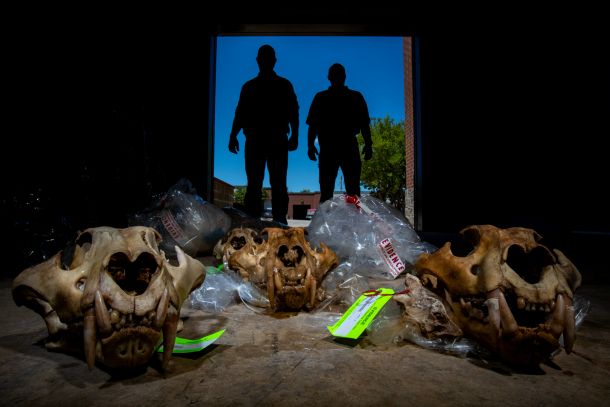
An undercover U.S. Fish and Wildlife agent and an Oklahoma Department of Wildlife Conservation agent display five tiger skulls excavated from what is now Greater Wynnewood Exotic Animal Park. They were evidence in a trial that convicted breeder Joe Exotic of killing, selling, and illegally transporting tigers—and two murder-for-hire charges. ©Steve Winter/National Geographic
Sharon Guynup (SG) is a journalist who has spent years reporting on the illegal wildlife trade in Asia. Sharon’s investigation for National Geographic into wildlife trafficking from Thailand’s infamous Tiger Temple, a monastery that doubled as a popular wildlife tourist attraction, helped pressure government officials to shutter the facility and rescue the temple’s 147 captive tigers. She worked with wildlife photojournalist, Steve Winter, on that story. Sharon’s reporting on this story earned her the 2017 Arlene Award “for an article that makes a difference” from the American Society of Journalists and Authors.
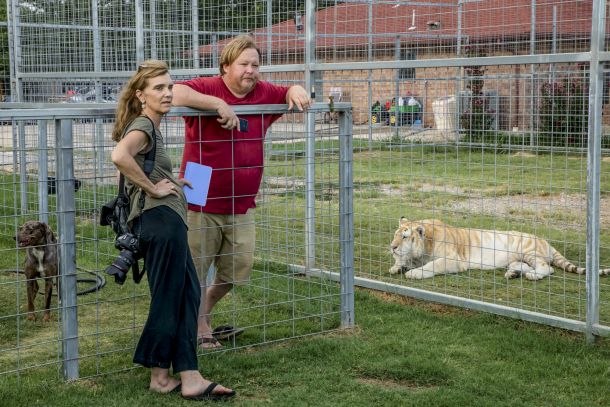
Sharon with James Garretson. Photo by Steve Winter
Steve Winter (SW) is a wildlife photojournalist who specializes in big cats. He has been contributing to National Geographic for close to three decades and has been named BBC Wildlife Photographer of the Year and BBC Wildlife Photojournalist of the Year. In November 2013, National Geographic Books published his work “Tigers Forever: Saving the World’s Most Endangered Cat” with text written by Sharon Guynup. Steve lectures globally on photography, big cats, and conservation issues.
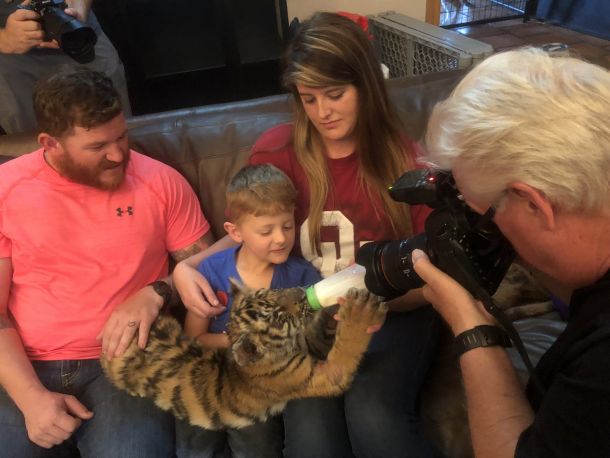
Steve on Assignment. Photo by Sharon Guynup.
Sharon and Steve have been documenting the captive tiger tourism industry in the United States since 2016. Over the course of their undercover investigation, they exposed the dark underbelly of hands-on tiger attractions that heavily breed, use, and then dump tiger cubs for profit. Their intrepid reporting was featured in “Captive tigers in the U.S. outnumber those in the wild. It’s a problem” an investigative feature published by National Geographic Magazine in December 2019. The Netflix series “Tiger King” has become hugely popular in the United States with its true crime tagline: “Murder, Mayhem and Madness”. However, Sharon and Steve believe the true victims of the show were not the larger-than-life characters, but the tigers themselves.
Q: Is there any conservation value in tiger tourism in the United States?
SG: There is no conservation value to tiger tourism. These animals are heavily inbred so they have inbreeding health problems, especially the white tigers. To breed a white cat, you have to breed father to daughter, mother to son, brother to sister because it is a recessive gene. So captive tigers at roadside zoos are either purposely inbred to create white tigers, or they are inbred because there is a small gene pool at these “tiger mill” breeding facilities. Females bang out two to three litters a year instead of one every two years like they would in the wild. Cubs are pulled from their mothers at birth, or within a couple of days. At four weeks they are passed around to hundreds if not thousands of guests until they are three to four months old and they outgrow their usefulness. They expire. They reach their expiration date. At that point they are too big and dangerous to pet.
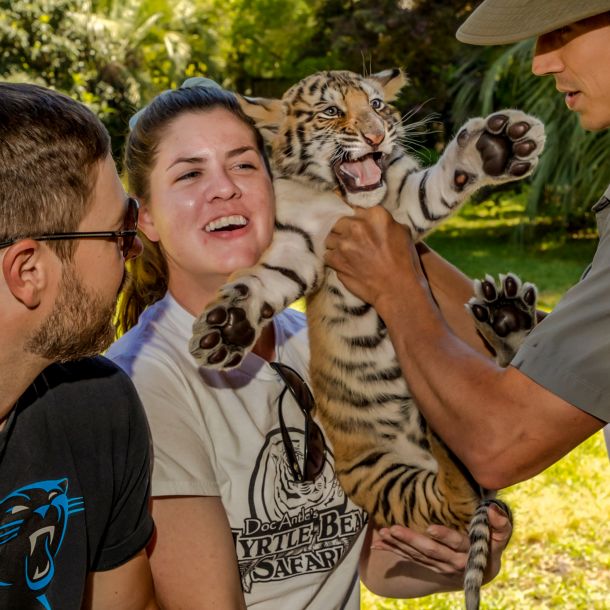
A tourist holds a tiger cub at Myrtle Beach Safari in South Carolina. ©Steve Winter/National Geographic
SW: No captive bred tigers have ever been successfully released into the wild—even tigers whose mothers were killed in the wild and were raised in enclosures in the middle of the forest with no tourists around. As soon as you let those cubs go, because they have been around humans, they go straight to a village, which endangers livestock or villagers themselves. People think that captive cats can be released, but they can’t. These cub-petting venues want people to think that their money is going to conservation. This is just not true.
SG: Many roadside zoos have nonprofit status where they masquerade as sanctuaries and rescues. A true sanctuary does not buy, trade, sell, breed or have hands-on contact with the cats. They make sure the animals have proper nutrition. They also get full vet and dental care and they keep the animals for life. That’s a really important distinction between a roadside zoo and a sanctuary. Which is never noted in Tiger King.
SW: One of the most important things that we forget are these tigers. When you look at Tiger King you see these eccentric people. But the tigers become objects. These animals are being reduced to objects, are mistreated and are not being viewed at as the incredible, majestic creatures that they are in the wild. They are demeaned. I think we have to put the tigers at the forefront.

A tiger cub displayed by Gregg Woody at the Ogle Country Fair in Illinois in 2018; under cover of darkness, he sold hands-on photo ops to visitors. He also displayed two giant ligers caged in a tractor trailer: ligers are crossbred tiger-lion mixes that do not exist in nature. They’re bred to attract tourists and have myriad health problems. ©Steve Winter/National Geographic
SG: To be clear, Tiger King was not a documentary. This was reality TV, true crime. If the U.S. was able to institute some responsible, federal legislation around big cat ownership we could possibly have some positive influence that will benefit conservation of wild tigers. This was not discussed in Tiger King at all.
Q: What led you to investigate the captive tiger trade in the United States?
SG: I was shocked when in a lecture, I heard Carson Barylak, a legal expert with the International Fund for Animal Welfare say that there were between 5,000 and 10,000 tigers living in cages in the United States and that there was no federal law governing big cat ownership. It was believed that some of those tigers were slipping into the illegal wildlife trade and were being trafficked across the United States. So that launched the investigation. We were undercover for 18 months. We wanted to keep a low profile so that we could see what was going on. Many of these cub petting venues are constantly vigilant for any kind of investigation. Because both the Humane Society of the United States and PETA have documented serious abuse and neglect that goes on behind the scenes.
SG: There are global implications here: there are only 4,000 wild tigers left. Tiger farms in China house at least 6,000 tigers and they, along with tiger farms in Thailand, Vietnam and Laos feed tiger parts into the illegal wildlife trade. Our lack of regulation in the U.S. tacitly condones tiger farming in those countries, and hamstrings our ability to influence illegal tiger trade at CITES (The Convention on International Trade in Endangered Species, an international treaty signed by 183 nations) or on the world stage. The demand for those products is driving poaching of the last 4,000 tigers. The U.S. has had some powerful conservation influence on other species, but we have absolutely no credibility when it comes to tigers.
SW: We wanted to show tangible results so that maybe we could move the needle to encourage China to do something if we were able to expose what was going on in the United States.
SG: The U.S. is one of seven countries currently under investigation for possible (captive-bred tiger) trafficking by CITES.
Q: How is captive tiger tourism linked with illegal wildlife trafficking?
SG: Tiger King focused on Joe Exotic’s murder for hire, but he was also convicted of 17 wildlife charges. He killed five tigers and illegally sold and trafficked tigers across state lines and across the country as our (U.S. tiger trade) map in our National Geographic story shows. This is in violation of the Endangered Species Act and the Lacey Act. Endemic to this industry is illegal wildlife trafficking.
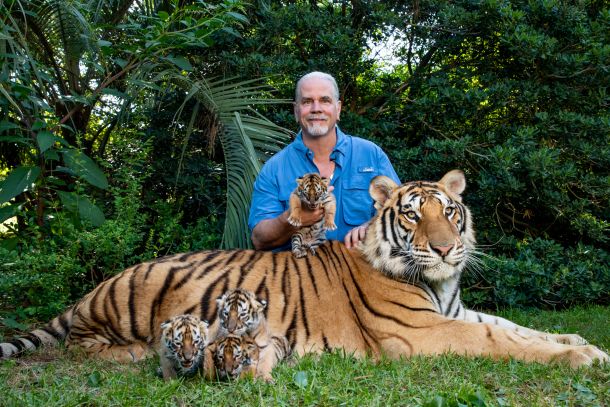
“Doc” Antle poses with weeks-old tiger cubs at his Myrtle Beach Safari entertainment facility in South Carolina. As part of a morning tour, tourists pet and are photographed with cubs—for $489 to $689 per person. These encounters require a constant supply of new babies; meanwhile, these venues’ animal inventories do not rise proportionately. What happens to cubs once they’re too big to pet? ©Steve Winter/National Geographic
SG: I would like to read you two paragraphs I wrote during the investigation to show you what I mean: Sitting through Joe’s six-day trial crystalized a key question. I wondered why some tiger owners seem to consider themselves above the law and harmed animals. Exotic cats seem to attract a distinct personality type, “a malignant narcissism with a distinctly masculine element,” said Leana Stormont, an attorney with the Humane Society of the United States, who specializes in animal crimes. The cats become status symbols, like trophies or luxury cars. Animal abuse, she said, is essentially the powerful preying on the weak and vulnerable. Perpetrators are five times more likely to commit violent crimes against people. They tend to cloak themselves in sanctimony, she said, making claims about conservation and declaring deep affection for animals. Many have a persecution complex: The USDA, animal rights activists, law enforcement, are out to get them. With 14 years as an FBI special agent, Congressman Fitzpatrick offered another insight: “There’s a lot of money to be made in this, which is why a lot of these criminals gravitate towards this.”
Q: How big of a business is captive tiger tourism?
SG: Many roadside zoos that call themselves nonprofits say they contribute to conservation, including Doc Antle. He is for-profit, but he has a nonprofit that overlaps in some concerning ways with his profit business.
SG: I made a very conservative estimate from a visit I made to Doc Antle’s Myrtle Beach Safari with Steve and my son Nick Ruggia last May. On a Saturday in mid-May, we observed a morning safari and a night safari, as well as one $5,000 private swim with a cub. I made the most conservative estimate possible and found that he made $50,000 that day. Doc Antle tells his customers that by showing up, they are supporting conservation. What does that really mean? If you look at his tax returns, a big chunk of what is claimed as non-profit donations goes to the care of his cats in his for-profit business.
SW: When we first started this story we heard this statement: A ten-cent bullet is cheaper than a $200 vet bill. Some vet bills can be extremely expensive and if these roadside zoos do not even have the money to feed their tigers, they are not going to spend the money on vet bills. The welfare of the animals needs to ultimately be what’s important.

Gir, six months old here, and his brother Forest (lion-liger hybrids) were rescued by Tiger Haven Sanctuary in Tennessee after they were abandoned by their owner because of health problems. Cubs used for petting and photo opportunities are usually pulled from their mothers as newborns. Later, when they get too big for these activities, they’re often abandoned, healthy or not. ©Steve Winter/National Geographic
SG: These cubs are disposable and they are dumped when they are no longer worth anything— when they grow too big and dangerous to pet. Some disappear. Some are killed, either as cubs or adults when they have outgrown their usefulness. Joe Exotic executed five tigers by shooting them in the head because they were no longer prolific breeders and buried them in the zoo’s garbage dump. One of those tigers was named Cuddles.

An undercover U.S. Fish and Wildlife agent and an Oklahoma Department of Wildlife Conservation agent display five tiger skulls excavated from what is now Greater Wynnewood Exotic Animal Park. They were evidence in a trial that convicted breeder Joe Exotic of killing, selling, and illegally transporting tigers—and two murder-for-hire charges. ©Steve Winter/National Geographic
SW: The U.S. Fish and Wildlife agent called the day they exhumed the tiger carcasses the worst day of his career.
Q: What went through your minds as you were touring these roadside zoos?
SW: We paid the normal entrance fees and entered as tourists, but we both have spent so much time with wild tigers, we had to put up a visual and emotional barrier to get through it.
SG: On the first trip we made, we went to a number of zoos in Florida. One of them was forced to close down, Dade City Wild Things, which had some of the worst conditions I saw in any of the 30-some roadside zoos we visited. I distinctly remember going back to our hotel room after one of those long days. Sitting on the bed putting my head in my hands I wondered how I was going to move forward with the story.
SW: We were crying when we were there.
SG: But then as a journalist, you dig in, you become analytical and every place you go you are looking for key information: How many cubs do they have? What is the caging like? Is it dangerous for the animals? Does it present a public safety risk because it is not secure? How many visitors are there? What is the staff doing? Are the animals fed? It becomes an investigation. But there were times throughout that took a real toll. Another moment that was really, really hard for me was sitting in the courtroom during Joe’s trial, the day they focused on the killing of the five tigers. It was like watching a CSI show. A forensic pathologist from the U.S. Fish and Wildlife Service talked about the entry and exit wounds, the ballistic velocity, analyzing how the animals died by looking at the bullet wounds in the skulls. It was chilling.
Q: Steve, as a wildlife photographer who specializes in big cats, how was it transitioning from photographing big cats in the wild versus documenting them in captivity?
SW: When you have the ability to see wild tigers in the jungle in India you get to see the light in their eyes. In these roadside zoos the tigers pace back and forth constantly and in many instances they have dead eyes. Some of them want to come up and chuff at the cage which is like saying hello to you, but many of them are just broken and in such small cages and in very bad situations.
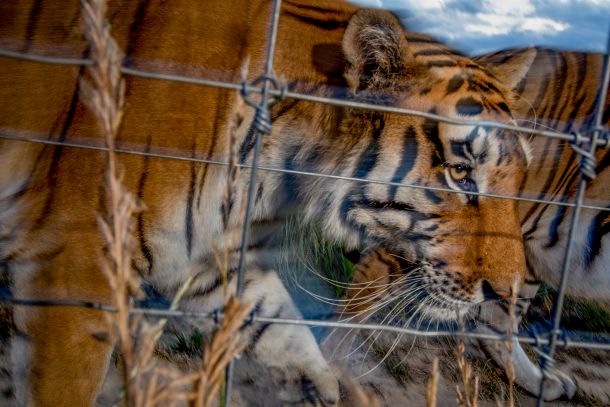
Rescued tigers at the Wild Animal Sanctuary in Keenesburg, Colorado. ©Steve Winter/National Geographic
Q: What are some actions the public can take to help protect captive big cats from being abused?
SG: Support the good sanctuaries in the United States and do not patronize and give places your money where you have hands-on contact with wildlife. Those who are concerned about this issue can contact their legislators. The Big Cat Public Safety Act has been introduced into both houses of Congress. The Act would create an overarching federal law on big cat ownership that would prohibit hands-on contact with tigers and prohibit breeding that did not fall into Species Survival Plan (SSP) conservation breeding programs of the five tiger subspecies. What has driven the proliferation of big cats in captivity in the US is the cub breeding and dumping for the hands-on, cub petting, photo-op, tourist industry. If tourists no longer patronize these places and if federal legislation then prohibits these activities, then the mass breeding will stop.
SW: Talking about good sanctuaries is important. Some of these true sanctuaries will give you more joy than the bad roadside zoos give you sadness. You can see what the great ones are doing and its absolutely incredible. They are bringing animals back from the brink of death and healing them and giving them a home with staff members that will love them and give them vet and dental care and a home for life. True sanctuaries do not breed, sell, trade or allow hands-on contact. One of the best is Pat Craig’s Wild Animal Sanctuary, the oldest and largest, almost 10,000 acres in Southern Colorado. These animals are living in huge habitats. Just two tigers are living in 35 acres. Turpentine Creek Wildlife Refuge in Arkansas is another incredible place. Their hearts are in the right place and they never give up. Contrary to what Tiger King seems to infer, Carole Baskin’s Big Cat Rescue is a true sanctuary.
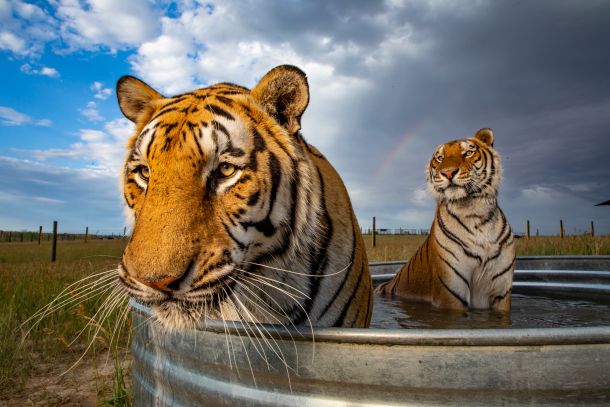
Clay and Daniel, two of 39 tigers rescued from an animal park in Oklahoma, gather at a pool at the Wild Animal Sanctuary in Keenesburg, Colorado. These cats will live out their lives here, with proper nutrition and vet care. ©Steve Winter/National Geographic
SG: The Global Federation of Animal Sanctuaries (GFAS) and Big Cat Sanctuary Alliance are two really good sources to find out which are true sanctuaries. Many roadside zoos masquerade as rescues or sanctuaries, but don’t meet the criteria.
Sources:
https://oalj.oha.usda.gov/sites/default/files/AWA_05-0014_012606.pdf
https://www.aphis.usda.gov/animal_welfare/downloads/forms/APHIS_Form_7003-7003A_Class-C_AppKit.pdf
https://www.nal.usda.gov/awic/animal-welfare-act
https://www.congress.gov/bill/116th-congress/house-bill/1380/text
https://www.nationalgeographic.com/animals/2019/11/map-shows-tiger-trade-in-united-states-feature/
https://www.nationalgeographic.com/travel/lists/activities/how-to-do-wildlife-tourism-right/
